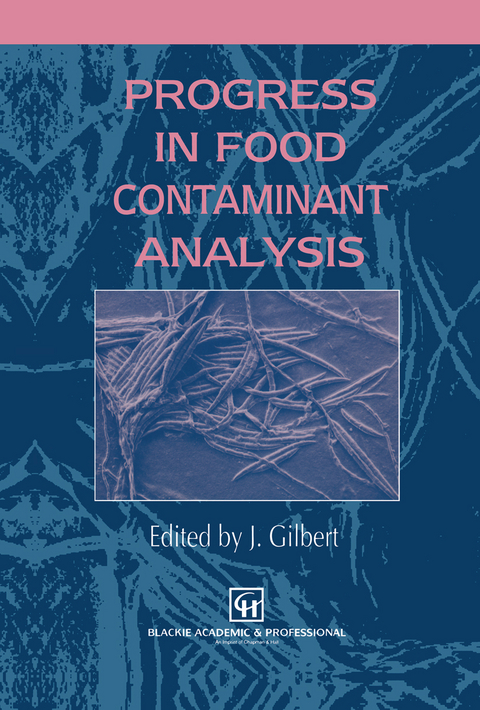
Progress in Food Contaminant Analysis
Springer-Verlag New York Inc.
978-1-4612-8425-3 (ISBN)
1 Sampling and sample plans for food surveillance exercises.- Summary.- 1.1 Introduction.- 1.2 Design of a sampling plan.- 1.3 Food surveillance exercises.- 1.4 Sampling of commodities for aflatoxins.- 1.5 Some other practical problems in food sampling.- 1.6 Sample pretreatment.- 1.7 Sampling equipment for foodstuffs.- 1.8 Conclusions.- References.- Appendix I Glossary of terms used in sampling.- 2 Automated clean-up techniques for trace component analysis in complex biological matrices including foods.- Summary.- Abbreviations.- 2.1 Introduction.- 2.2 Rationale for automating trace analysis.- 2.3 Criteria for selecting methods for automation.- 2.4 Advantages of automation.- 2.5 Disadvantages of automation.- 2.6 Methods for automation.- 2.7 Electrophoresis.- 2.8 Data reduction.- 2.9 Conclusions.- References.- 3 Chromatographic and allied methods of analysis for selected mycotoxins.- Summary.- 3.1 Introduction.- 3.2 Aflatoxins in food commodities.- 3.3 Aflatoxin M1 in milk.- 3.4 Fumonisins.- 3.5 Ochratoxin A.- 3.6 Patulin.- 3.7 Trichothecenes (deoxynivalenol, nivalenol, diacetoxyscirpenol and T-2 toxin).- 3.8 Zearalenone.- 3.9 Multi-mycotoxin methods.- 3.10 Conclusions.- References.- 4 Inductively coupled plasma-mass spectrometry (ICP-MS) for the analysis of trace element contaminants in foods.- Summary.- Abbreviations.- 4.1 Introduction.- 4.2 Principles of ICP-MS.- 4.3 The advantages and disadvantages of ICP-MS.- 4.4 Sample preparation.- 4.5 Total analyte determinations.- 4.6 Speciation studies of foods.- 4.7 Future developments.- References.- 5 Applications of immunoassay to pesticide analysis.- Summary.- 5.1 Introduction.- 5.2 Pesticide determination by immunoassay.- 5.3 Commercial pesticide immunoassay kits.- 5.4 Official evaluation/acceptance of pesticide immunoassay kits.- 5.5 Conclusions.- References.- 6 Bioassay and chemical methods for analysis of paralytic shellfish poison.- Summary.- 6.1 Introduction.- 6.2 Biological methods.- 6.3 Biochemical assays.- 6.4 Chemical methods.- 6.5 Conclusions.- References.- 7 Analysis of food contaminants by combined liquid chromatography-mass spectrometry (LC-MS).- Summary.- Abbreviations.- 7.1 Introduction.- 7.2 Developments in LC-MS interfacing.- 7.3 Coupling of other chromatographic methods.- 7.4 Applications of LC-MS to food contaminants.- 7.5 Conclusions.- References.- 8 Analysis of foods and biological samples for dioxins and PCBs by high resolution gas chromatography-mass spectrometry.- Summary.- 8.1 Introduction.- 8.2 Nomenclature.- 8.3 Sample preparation and clean-up.- 8.4 GC-MS methodology.- 8.5 Examples of analysis.- References.- 9 Approaches to evaluating high-temperature food packaging materials as sources of food contamination.- Summary.- 9.1 Introduction.- 9.2 Microwave susceptors—sizzling hot food packaging materials.- 9.3 Volatile chemicals produced during susceptor heating.- 9.4 Non-volatile chemical residues.- 9.5 Test cell considerations for microwave environments.- 9.6 Recovery and analysis of migrating chemicals.- 9.7 Possible food alteration products.- 9.8 Temperature measurements.- 9.9 Supercritical fluid extraction and chromatography for assessing sources of food contamination.- 9.10 Modelling additive migration from polymers to foods.- 9.11 Experimental determination of diffusion coefficients.- 9.12 Functional barrier considerations in recycled polymer applications.- References.- 10 Progress in developing European statutory methods of analysis.- Summary.- 10.1 Introduction.- 10.2 Legislation—The EU Food Control Directive.- 10.3 Accreditation.- 10.4 InternalQuality Control: Harmonised Guidelines For Internal Quality Control In Analytical Chemistry Laboratories.- 10.5 Proficiency testing: ISO/IUPAC/AOAC INTERNATIONAL Harmonised Protocol For Proficiency Testing Of (Chemical) Analytical Laboratories.- 10.6 Methods of analysis.- 10.7 Collaborative trials.- 10.8 Methods of analysis being developed by CEN for food additives and contaminants.- 10.9 Conclusions.- References.
| Zusatzinfo | XIV, 426 p. |
|---|---|
| Verlagsort | New York, NY |
| Sprache | englisch |
| Maße | 155 x 235 mm |
| Themenwelt | Technik ► Lebensmitteltechnologie |
| Technik ► Umwelttechnik / Biotechnologie | |
| ISBN-10 | 1-4612-8425-2 / 1461284252 |
| ISBN-13 | 978-1-4612-8425-3 / 9781461284253 |
| Zustand | Neuware |
| Haben Sie eine Frage zum Produkt? |
aus dem Bereich


